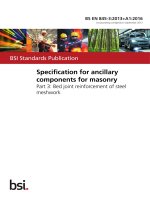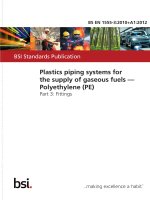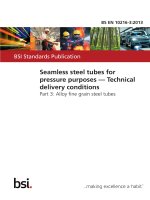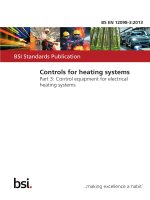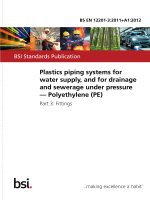Bsi bs en 61000 3 3 2013
Bạn đang xem bản rút gọn của tài liệu. Xem và tải ngay bản đầy đủ của tài liệu tại đây (1.43 MB, 38 trang )
BS EN 61000-3-3:2013
BSI Standards Publication
Electromagnetic
compatibility (EMC)
Part 3-3: Limits – Limitation of voltage
changes, voltage fluctuations and flicker in
public low-voltage supply systems, for
equipment with rated current ≤ 16 A per
phase and not subject to conditional
connection
BS EN 61000-3-3:2013 BRITISH STANDARD
Text affected
EUROPEAN STANDARD EN 61000-3-3
NORME EUROPÉENNE
EUROPÄISCHE NORM August 2013
ICS 33.100.10 Supersedes EN 61000-3-3:2008
English version
Electromagnetic compatibility (EMC) -
Part 3-3: Limits -
Limitation of voltage changes, voltage fluctuations and flicker in public
low-voltage supply systems, for equipment with rated current ≤ 16 A per
phase and not subject to conditional connection
(IEC 61000-3-3:2013)
Compatibilité électromagnétique (CEM) - Elektromagnetische Verträglichkeit
Partie 3-3: Limites - (EMV) -
Limitation des variations de tension, des Teil 3-3: Grenzwerte -
fluctuations de tension et du papillotement Begrenzung von Spannungsänderungen,
dans les réseaux publics d'alimentation Spannungsschwankungen und Flicker in
basse tension, pour les matériels ayant un öffentlichen Niederspannungs-
courant assigné ≤ 16 A par phase et non Versorgungsnetzen für Geräte mit einem
soumis à un raccordement conditionnel Bemessungsstrom ≤ 16 A je Leiter, die
(CEI 61000-3-3:2013) keiner Sonderanschlussbedingung
unterliegen
(IEC 61000-3-3:2013)
This European Standard was approved by CENELEC on 2013-06-18. CENELEC members are bound to comply
with the CEN/CENELEC Internal Regulations which stipulate the conditions for giving this European Standard
the status of a national standard without any alteration.
Up-to-date lists and bibliographical references concerning such national standards may be obtained on
application to the CEN-CENELEC Management Centre or to any CENELEC member.
This European Standard exists in three official versions (English, French, German). A version in any other
language made by translation under the responsibility of a CENELEC member into its own language and notified
to the CEN-CENELEC Management Centre has the same status as the official versions.
CENELEC members are the national electrotechnical committees of Austria, Belgium, Bulgaria, Croatia, Cyprus,
the Czech Republic, Denmark, Estonia, Finland, Former Yugoslav Republic of Macedonia, France, Germany,
Greece, Hungary, Iceland, Ireland, Italy, Latvia, Lithuania, Luxembourg, Malta, the Netherlands, Norway, Poland,
Portugal, Romania, Slovakia, Slovenia, Spain, Sweden, Switzerland, Turkey and the United Kingdom.
CENELEC European Committee for Electrotechnical Standardization
Comité Européen de Normalisation Electrotechnique
Europäisches Komitee für Elektrotechnische Normung
Management Centre: Avenue Marnix 17, B - 1000 Brussels
© 2013 CENELEC - All rights of exploitation in any form and by any means reserved worldwide for CENELEC members.
Ref. No. EN 61000-3-3:2013 E
BS EN 61000-3-3:2013 – 2 –
EN 61000-3-3:2013 -2-
EN 61000-3-3:2013
Foreword
The text of document 77A/809/FDIS, future edition 3 of IEC 61000-3-3, prepared by SC 77A, "EMC - Low
frequency phenomena", of IEC TC 77, "Electromagnetic compatibility" was submitted to the
IEC-CENELEC parallel vote and approved by CENELEC as EN 61000-3-3:2013.
The following dates are fixed:
• latest date by which the document has (dop) 2014-03-18
to be implemented at national level by (dow) 2016-06-18
publication of an identical national
standard or by endorsement
• latest date by which the national
standards conflicting with the
document have to be withdrawn
This document supersedes EN 61000-3-3:2008.
EN 61000-3-3:2013 includes the following significant technical changes with respect to
EN 61000-3-3:2008:
This edition takes account of the changes made in EN 61000-4-15:2011.
Attention is drawn to the possibility that some of the elements of this document may be the subject of
patent rights. CENELEC [and/or CEN] shall not be held responsible for identifying any or all such patent
rights.
This document has been prepared under a mandate given to CENELEC by the European Commission
and the European Free Trade Association, and supports essential requirements of EU Directive(s).
For the relationship with EU Directive(s) see informative Annex ZZ, which is an integral part of this
document.
Endorsement notice
The text of the International Standard IEC 61000-3-3:2013 was approved by CENELEC as a European
Standard without any modification.
– 3 – BS EN 61000-3-3:2013
-3- EN 61000-3-3:2013
EN 61000-3-3:2013
Annex ZA
(normative)
Normative references to international publications
with their corresponding European publications
The following documents, in whole or in part, are normatively referenced in this document and are
indispensable for its application. For dated references, only the edition cited applies. For undated
references, the latest edition of the referenced document (including any amendments) applies.
NOTE When an international publication has been modified by common modifications, indicated by (mod), the relevant EN/HD
applies.
Publication Year Title EN/HD Year
IEC/TR 60725 - -
Consideration of reference impedances and -
IEC 60974-1 - public supply network impedances for use in -
IEC 61000-3-2 - determining disturbance characteristics of -
electrical equipment having a rated current -
IEC 61000-3-11 - ≤ 75 A per phase
2011
IEC 61000-4-15 2010 Arc welding equipment - EN 60974-1
+ corr. March 2012 Part 1: Welding power sources
Electromagnetic compatibility (EMC) - EN 61000-3-2
Part 3-2: Limits - Limits for harmonic current
emissions (equipment input current ≤ 16 A per
phase)
Electromagnetic compatibility (EMC) - EN 61000-3-11
Part 3-11: Limits - Limitation of voltage
changes, voltage fluctuations and flicker in
public low-voltage supply systems -
Equipment with rated current ≤ 75 A and
subject to conditional connection
Electromagnetic compatibility (EMC) - EN 61000-4-15
Part 4-15: Testing and measurement
techniques - Flickermeter - Functional and
design specifications
BS EN 61000-3-3:2013 – 4 –
EN 61000-3-3:2013 -4-
EN 61000-3-3:2013
Annex ZZ
(informative)
Coverage of Essential Requirements of EU Directives
This European Standard has been prepared under a mandate given to CENELEC by the European
Commission and the European Free Trade Association and within its scope the standard covers
protection requirements of Annex I Article 1(a) of the EU Directive 2004/108/EC and protection
requirements of Article 3.1(b) (emissions only) of the EU Directive 1999/5/EC.
Compliance with this standard provides one means of conformity with the specified essential
requirements of the Directives concerned.
WARNING: Other requirements and other EU Directives may be applicable to the products falling within
the scope of this standard.
– 2 – 61000-3-3 © IEC:2013
– 2 – 61000-3-3 © IEC:2013
– 2 – 6B1S00E0N-36-130©00I-E3C-3::22001133
CONT–E5N–TS EN 61000-3-3:2013
CON–T2E–NTS 61000-3-3 © IEC:2013
FOREWORD ..........................................C...O...N...T..E...N...T..S.............................................................. 4
FOREW ORD ........................................................................................................................... 4
IFNOTRREOWDOURCDTI.O...N......................................C...O...N...T..E...N...T..S.............................................................. 46
INTRODUCTION ..................................................................................................................... 6
1INTRSOcoDpUeC..T..I.O...N....................................................................................................................... 76
1FORSEcWopOeR..D............................................................................................................................. 74
21 NScoormpea.t.i.v.e...r.e..f.e..r..e.n..c..e..s......................................................................................................... 7
2INTRNOoDrmUaCtiTvIeOrNef.e..r..e.n..c..e..s......................................................................................................... 76
32 TNeormsataivned rdeefefirneintiocens .......................................................................................................87
31 TSecrompes .a..n..d...d..e..f.i.n..it.i.o..n..s......................................................................................................... 78
43 ATessrmesssamnedndt eoffinviotilotangse..c..h..a..n..g..e..s.,...v.o..l.t.a..g..e...f.l.u..c.t.u..a..t.i.o..n..s...a.n..d...f.l.i.c..k.e..r.......................................1.08
42 ANsosrmesastmivenrteofefrveonlctaegse..c..h..a..n..g..e..s.,...v.o..l.t.a..g..e...f.l.u..c.t.u..a..t.i.o..n..s...a.n..d...f.l.i.c..k.e..r.......................................1.07
4 4A.s1sesAsmsseenstsomf evnotltoafgae rcehlantigvesv,ovltoaltgaegechfaluncgteu,atdi(otn).s...a.n..d...f.l.i.c..k.e..r...................................... 10
3 4T.e1rmsAasnsdesdsemfiennittioonfsa..r.e..l.a..t.i.v..e...v.o..l.t.a..g..e...c..h..a.n..g..e..,..d..(.t.)..........................................................1.08
44..12 AAsssseessssmmeenntt ooff tahereslahtoivret-tveormltagfleickcehravnagleu,ed, (Pt)s..t........................................................................................................... 1100
4 4A.s2sesAsmsseenstsomf evnotltoafgtehechsahnogret-ste, rvmoltfalicgkeefrluvcatluuaet,ioPnsst .a.n..d...f.l.i.c..k.e..r...................................... 10
4.2 4A.s2s.e1ssmGeennteoraf lth..e...s..h..o..r.t.-.t.e..r.m....f.l.i.c..k.e..r..v..a..l.u..e..,..P..s..t........................................................................................................... 1100
4.1 44A..s22s..e21ssmFGleeicnnkteeorrafmla.e.rt.ee..lr.a...t..i..v....e......v..o....l..t..a....g....e......c....h....a..n....g....e....,....d....(..t..).......................................................................................................................................................................... 111100
4.2.1 General ..................................................................................................... 10
4.2 44A..s22s..e32ssmSFleiimcnktueloarfmtitohenetemsr h.e.ot.h.r.to.-.td.e...r..m........f..l..i..c....k..e....r....v....a....l..u....e....,....P....s....t................................................................................................................................................................. 111110
4.2.2 Flickermeter .............................................................................................. 11
444...222...431 ASGniemanuleylrtaaictliao..ln.m..m.e..et.ht.h.o.o.d.d.................................................................................................................................................................................................................................................................. 111110
4.2.3 Simulation method .....................................................................................11
444...222...542 UAFlnsiceaklyoetfrimcPaeltme=re1.t.h.c.o.u.d.r.v....e.......................................................................................................................................................................................................................................................... 111211
4.2.4 Analyticasltmethod ...................................................................................... 11
4.3 A44..s22s..e53ssmUSeismnetuoloafftPiloosnnt g=m-t1eetrchmuordfvl.ei.c.k....e....r....v....a....l..u....e....,....P............................................................................................................................................................................................... 111221
4.2.5 Use of Pst = 1 curve ...................l.t.............................................................. 12
5 L4.im3 itsA4...s.2.s..e.4.s..s..mA...en.n.a.t.ly.o.t.if.c.l.ao..ln.m.g..-e.t.et.h.r.om..d..f..l..i..c..k....e....r....v....a....l..u....e....,....P....l..t......................................................................................................................................................................................... 111221
4.3 Assessment of long-term flicker value, Plt .............................................................12
5 Limits4....2....5.....U...s..e...o.f...P..s.t..=...1...c..u..r.v..e...................................................................................................................................................................... 1122
65 TLiemsittsco..n..d..i.t.io..n..s................................................................................................................. 132
6 T4.e3st cAosnsdeitsiosnmse.n..t..o..f..l.o..n..g..-.t.e..r.m....f.l.i.c.k..e..r..v..a..l.u..e..,..P..l.t.............................................................. 123
6 6T.e1st cGonednietiroanl s................................................................................................................. 13
5 6L.im1 itsG..e..n..e..r.a..l.................................................................................................................. 123
66..21 MGeenaesruarel .m...e..n..t..u..n.c..e..r.t.a..i.n..t.y.............................................................................................................................................................................. 1143
6 6T.e2st cMonedaistiuornesm..e..n..t..u..n.c..e..r.t.a..i.n..t.y........................................................................................ 134
66..32 TMeesatssuurpepmlyenvtoultnacgeert.a..i.n..t.y.............................................................................................................................................................................. 1144
666...431 RTGeeesfnetersreuanplc.p.e.l.y.im.v..op..le.t.ad..ga..en..c....e...................................................................................................................................................................................................................................................................................... 111443
6.3 Test supply voltage ............................................................................................... 14
666...542 ORMebefsaeesrruevrnaectmeioenimnptpeuerndiocadenr.ct.a.e.i..n....t..y...................................................................................................................................................................................................................................................................... 111444
6.4 Reference impedance............................................................................................14
666...653 GOTeebssnteesrrvuaapl tptieolysntvpcoeoltrnaiodgideti.o....n....s................................................................................................................................................................................................................................................................................ 111544
6.5 Observation period ................................................................................................ 14
Anne66x..64A (nGRoeerfnmeeraretanivlcetee)simtAcppopenldidcaiantitcoioenn.s...o....f....l..i..m....i..t..s......a....n....d......t..y..p....e......t..e....s....t....c....o....n....d....it..i..o....n....s......f..o....r....s....p....e..c....i..f..i..c.............................................. 1154
6.6 General test conditions..........................................................................................15
eAqnunie6px.m5Aen(tnO.o.b.r.sm..e.a.r.vt.i.av..te.i.o).n..A.p.p.e.p.r.li.io.c.da..t.i.o..n...o..f..l.i.m..i.t.s...a..n..d...t.y..p.e...t.e..s..t..c..o..n..d..it.i.o..n..s...f.o..r..s..p..e..c.i.f.i.c....................... 194
AeqnuniepxmAen(tn.o..r.m...a..t.i.v..e..)...A..p..p..l.i.c.a..t.i.o..n...o..f..l.i.m..i.t.s...a..n..d...t.y..p.e...t.e..s..t..c..o..n..d..it.i.o..n..s...f.o..r..s..p..e..c.i.f.i.c....................... 19
Aeqnunie6px.m6Ben(tnG.o.e.r.nm..e.a.r.ta.i.vl..et.e.).s..tT..ce.o.s.n.t.d.c.io.t.in.o.d.n.i.st.i..o....n....s....a....n....d......p....r..o....c....e....d....u....r..e....s....f...o...r......m....e....a....s....u....r..i..n....g......d..m......a....x......v....o....lt...a...g....e.................................. 1195
cAAhnnannneegxxeBAs c((nnaoourrsmmeaadttiibvvyee))maTAnepuspatlilccsoawntioditnictihooinnf sglima..ni.t.ds...ap..nr.o.d.c..te.y.dp..ue..r.et.e.s.s.f.to..cr..o.m.n.e.d.a.it.si.o.u.n.r.si.n..fg.o..dr.m.s..pa..ex.c..vi.f.oi.c.lt.a..g..e................. 27
cAehqnaunniepgxmeBsenc(tna.o.u.r.sm.e..ad..t.ib.v.y.e..)m...aT..ne..us..at.l.c.so..wn..di.t.ic.t.ih.o.i.nn..sg..a....n....d......p....r..o....c....e....d....u....r..e....s....f...o...r......m....e....a....s....u....r..i..n....g......d..m......a....x......v....o....lt...a...g....e.................................. 2179
cAhnannegxeCs c(ianufosremdabtiyvem)aDnueatel rsmwiintcahtiionng o..f..s..t.e..a..d..y..s..t.a..t.e...v..o..l.t.a..g.e...a..n..d...v..o..l.t.a..g.e...c..h..a..n..g..e.................. 27
cAAhnnannreeaxxctCBer((insintoifcromsrm,aataisvtievd)ee)fTinDeesedttecinromnIEidnCiatito6ion1ns00oa0fn-ds4t-ep1ar5od:cy2e0sd1tua0rtee..s.v.f.oo..lr.t.a.mg..ee..a.a.s.n.u.d.r.i.nv..og..l.td.am.g..ae..x.c..vh..oa..lnt.a.g.g.e.e................. 28
cAhnanreaxctCer(isintifcosrm, aastivdee)finDeedteinrmIEinCat6io1n00o0f -s4t-e1a5d:y20s1ta0te...v..o..l.t.a.g..e...a..n..d...v..o..l.t.a.g..e...c..h..a..n..g..e.................. 28
ccAhhnaanrneagxcetDserc(isiantuifcossrem,daabstiyvdeme)fainnIenudpaulintsrwIeEiltaCcthi6vine1g0v0.o.0.l.t-.a4.g.-.1e..5.f.:l.2u..0c..1t.u.0.a...t..i..o..n......∆....V....../..V......f..o....r....P....s....t....=......1....,..0......a....t....o....u....t..p....u....t.......................... 2278
[AAIEnnnnCee/TxxRDC6((1iinn0ff0oo0rrmm-3aa-tt7iivv:2ee0)) 0DI8n]ep.t.ue..tr.m.r.e.i.nl.a.a.t.itv.io.e.n..v.o.o.f.l.ts.a.t.ge.e.a..df.l.yu..cs..tt.ua..at.e.t.i.ov.n.o..l∆.t.a.V.g./e.V..a.f.on..rd..P.v.s.o.t.l.t=.a..g1.e.,.0.c..ah..ta..on..ug..te.p..u..t............. 33
[cAIhEnanCre/aTxcRtDer6(i1sint0ifc0os0rm,-3aa-st7ivd:2ee0)fi0nI8en]dp..u.i.nt..rI.e.E.l.aC..t.i6v..e1..0.v.0.o.0.l.t-.a4..g-.1e..5.f.:l.2u..0c..1t.u.0.a...t..i..o..n......∆.....V...../..V......f..o....r....P....s....t....=......1....,..0......a....t....o....u....t..p....u....t.......................... 3238
[BIEibClio/TgRra6p1h0y0..0..-.3..-.7..:.2..0..0..8..]....................................................................................................... 334
BAinbnlieoxgrDap(ihnyfo..r.m...a..t.i.v..e..)...I.n..p..u..t..r.e..l.a..t.iv..e...v..o..l.t.a..g.e...f.l.u..c..t.u..a..t.i.o.n...∆...V../.V...f.o..r..P......=...1..,.0...a..t..o..u..t.p..u..t............. 34
Bibliography...................................................................................s..t..................................... 34
[IEC/TR 61000-3-7:2008] ...................................................................................................... 33
Figure 1 – Reference network for single-phase and three-phase supplies derived from
aFBitgbhulrioreeger-1app–hhaRyse.e.f.,e..fr.oe..un.r.c.-.we..i.nr.e.e..ts.w.u.o.p.r.pk..l.yf.o....r....s....i..n....g....le....-....p..h....a....s....e......a....n....d......t..h....r..e....e....-..p....h....a....s..e......s....u....p....p....l..ie....s......d....e....r..i..v....e....d....f..r....o....m...................... 1364
aFitghurreee-1p–haRseef,efroeunrc-we inreetswuoprpklyfo..r..s..i.n..g..le..-..p.h..a..s..e...a..n..d...t.h..r.e..e..-.p..h..a..s.e...s..u..p..p..l.ie..s...d..e..r.i.v..e..d..f.r..o..m........... 16
aFitghurreee-2p–haCsuer,vfeoufor-rwPirset =su1ppfolyr .r.e..c..t.a..n..g..u..l.a.r...e..q.u..i.d..i.s..t.a..n..t..v.o..l.t.a..g..e...c..h.a..n..g..e..s................................ 176
FFiigguurree 21 –– CRuerfeverefnocrePnset t=w1orfkorforrescitnagnlgeu-plahraesqeuaidnidsttahnrteveo-plthaagseecshuapnpgleiess..d..e..r.i.v..e.d...f.r..o..m........... 17
Figure 32 – SChuarvpee ffoarcPtosrts=F1fofor rdroeucbtalen-gsutelapr aenqduirdaimstpa-nvtovltoalgtaegcehcahranctgeersis.t.i.c.s.......................... 17
aFitghurreee-3p–haSshea, pfoeufra-cwtiorerssFupfoprlyd..o.u..b..l.e..-.s..t.e..p...a..n..d...r.a..m...p.-..v.o..l.t.a..g..e...c..h.a..r..a.c..t.e..r.i.s..t.i.c..s......................... 176
Figure 43 – Shape factors F for dreocutbalneg-ustlaerp aanndd traiamnpg-uvloalrtavgoeltacghearcahcateraricstteicriss.t.i.c.s.................... 178
Figure 42 – SChuarvpee ffoarcPtosrts=F1fofor rrerecctatanngguulalar raenqdutirdiaisntgauntlavrovltoaltgaegcehcahnagreasct.e..r.i.s..t.i.c.s.................... 178
Figure 54 – Shape factorsFFfofor rmroetcotar-nsgtaurltavr oalntadgteriacnhgarualacrtevroisltaicgsehcahvainragcvtearriisotuicssf.r.o..n..t............ 18
tFimigeusre...53...–...S..h..a..p..e...f.a..c..t.o.r..s.F.F..f.of..or.r.m..d.o.o.tu.o.b.r.-l.se..t-.as..rt.te..vp..o.a.lt.na..dg..e.r.a.c.m.h..pa.-.r.va.o.c.l.tt.ea.r.g.is.e.t.i.c..hs.a..hr.a..vc..it.ne..gr.i.s.v.t.ai.cr..sio...u....s......f..r..o....n....t........................ 1178
tFFimiiggeuusrree...54...––...SS..hh..aa..pp..ee...ff.aa..cc..tt.oo.rr..s.F.F..f.of..or.r.m..r.oe..tc.ot.a.r.-n.s.g.t.au..rl.ta..vr..oa..lnt.a.d.g..te.r.i.ac..nh..ga..ru.a.la.c.r.t.e.vr.o.is.l.tt.ai.c.g.s.e..h.ca..hv.a.i.nr..ag.c..vt.e.a.rr.i.iso..tu.i.cs.s..f..r..o....n....t........................ 1188
tFimigeusre...C....1..–...E...v.a..l.u..a..t.i.o..n...o..f..U..h..p..(.t.)........................................................................................... 3128
FFiigguurree C5 .–1 S–hEavpaelufaactitoonr oFffUorhmp(ot)t.o.r..-.s..t.a..r.t..v..o.l.t.a..g..e...c..h..a..r.a..c.t.e..r..is..t.i.c..s...h.a..v..i.n..g...v.a..r..io..u..s...f.r.o..n..t............ 32
Figure C.1 – Evaluation of Uhp(t) .......................................................................................... 32
times..................................................................................................................................... 18
Table 1 – Assessment method .............................................................................................. 11
TFiagbulree1C–.1A–ssEevsaslmuaetniot nmoefthUohdp.(.t.)........................................................................................... 3121
Table 1A.–1 A–sTseesstscmoenndtitmioentshofodr..h..o.t.p..l.a..t.e..s................................................................................ 191
Table A.1 – Test conditions for hotplates .............................................................................. 19
Table A.21 – TEelescttrcoodnediptiaornasmfeotrehrsot.p..l.a..t.e..s................................................................................ 2149
6T1a0b0le0-1A3.–-23A–©sEsIleEesCcst:rm2o0ed1ne3t pmaerathmoedte..r.s...................–...3...–.................................................................. 2141
Table A.32 – FErlecqturoednecypfaarcatmoreRtersel.a..t.e..d...t.o...r.e..p..e..t.i.t.i.o.n...r..a.t..e.."..r."................................................... 254
Table A.31 – TFreesqt uceonncdyitifoancstofroRr hreoltaptleadtetso..r.e..p..e..t.i.t.i.o.n...r..a.t.e..."..r."................................................... 2159
Table CA.31 – FTreesqt usepneccyififcaacttioornRforreldacte–ddtmo arexp–etidt(iot)n>ra3t,e3 "%r"(..f.r.o..m....T..a..b..le...1..2...o..f........................ 25
Table A.2 – Electrode parameters ......................................................................................... 24
IEC 61000-4-15: 2010).......................................................................................................... 31
Table A.3 – Frequency factor R related to repetition rate "r"..................................................25
Table C.2 – Test specification for dc – dmax – td(t) > 3,3 % (from Table 13 of
IEC 61000-4-15: 2010).......................................................................................................... 31
Table D.1 – Input relative voltage fluctuation ∆V/V for Pst = 1,0 at output .............................33
BS EN 61000-3-3:2013 – 6 –
EN 61000-3-3:2013
– 6 – 61000-3-3 © IEC:2013
INTRODUCTION
IEC 61000 is published in separate parts according to the following structure:
Part 1: General
General considerations (introduction, fundamental principles)
Definitions, terminology
Part 2: Environment
Description of the environment
Classification of the environment
Compatibility levels
Part 3: Limits
Emission limits
Immunity limits (in so far as they do not fall under the responsibility of product
committees)
Part 4: Testing and measurement techniques
Measurement techniques
Testing techniques
Part 5: Installation and mitigation guidelines
Installation guidelines
Mitigation methods and devices
Part 9: Miscellaneous
Each part is further subdivided into sections which are to be published either as International
Standards or as Technical Reports.
These standards and reports will be published in chronological order and numbered
accordingly.
– 7 – BS EN 61000-3-3:2013
EN 61000-3-3:2013
61000-3-3 © IEC:2013 – 7 –
ELECTROMAGNETIC COMPATIBILITY (EMC) –
Part 3-3: Limits – Limitation of voltage changes, voltage fluctuations and
flicker in public low-voltage supply systems, for equipment with rated
current ≤ 16 A per phase and not subject to conditional connection
1 Scope
This part of IEC 61000 is concerned with the limitation of voltage fluctuations and flicker
impressed on the public low-voltage system.
It specifies limits of voltage changes which may be produced by an equipment tested under
specified conditions and gives guidance on methods of assessment.
This part of IEC 61000 is applicable to electrical and electronic equipment having an input
current equal to or less than 16 A per phase, intended to be connected to public low-voltage
distribution systems of between 220 V and 250 V line to neutral at 50 Hz, and not subject to
conditional connection.
Equipment which does not comply with the limits of this part of IEC 61000 when tested with
the reference impedance Zref of 6.4, and which therefore cannot be declared compliant with
this part, may be retested or evaluated to show conformity with IEC 61000-3-11. Part 3-11 is
applicable to equipment with rated input current ≤ 75 A per phase and subject to conditional
connection.
The tests according to this part are type tests. Particular test conditions are given in Annex A
and the test circuit is shown in Figure 1.
NOTE 1 The limits in this standard relate to the voltage changes experienced by consumers connected at the
interface between the public supply low-voltage network and the equipment user’s installation. Consequently, if the
actual impedance of the supply at the supply terminals of equipment connected within the equipment user’s
installation exceeds the test impedance, it is possible that supply disturbance exceeding the limits could occur.
NOTE 2 The limits in this standard are based mainly on the subjective severity of flicker imposed on the light from
230 V 60 W coiled-coil filament lamps by fluctuations of the supply voltage. For systems with nominal voltage less
than 220 V line to neutral and/or frequency of 60 Hz, the limits and reference circuit values are under
consideration.
2 Normative references
The following documents, in whole or in part, are normatively referenced in this document and
are indispensable for its application. For dated references, only the edition cited applies. For
undated references, the latest edition of the referenced document (including any
amendments) applies.
IEC/TR 60725, Consideration of reference impedances and public supply impedances for use
in determining disturbance characteristics of electrical equipment having a rated current
≤ 75 A per phase
IEC 60974-1, Arc welding equipment – Part 1: Welding power sources
IEC 61000-3-2, Electromagnetic compatibility (EMC) – Part 3-2: Limits – Limits for harmonic
current emissions (equipment input current ≤ 16 A per phase)
BS EN 61000-3-3:2013 – 8 –
EN 61000-3-3:2013
– 8 – 61000-3-3 © IEC:2013
IEC 61000-3-11, Electromagnetic compatibility (EMC) – Part 3-11: Limits – Limitation of
voltage changes, voltage fluctuations and flicker in public low-voltage supply systems –
Equipment with rated current ≤ 75 A and subject to conditional connection
IEC 61000-4-15:2010, Electromagnetic compatibility (EMC) – Part 4-15: Testing and
measurement techniques – Flickermeter – Functional and design specifications
3 Terms and definitions
For the purposes of this document, the following terms and definitions apply.
3.1
flicker
impression of unsteadiness of visual sensation induced by a light stimulus whose luminance
or spectral distribution fluctuates with time
[SOURCE: IEC 60050-161:1990, 161-08-13]
3.2
voltage change characteristic
d(t)
time function of the relative r.m.s. voltage change evaluated as a single value for each
successive half period between zero-crossings of the source voltage, except during time
intervals in which the voltage is in a steady-state condition for at least 1 s
Note 1 to entry: For detailed information about the evaluation of a voltage change characteristic and the definition
of a steady state condition see Annex C and IEC 61000-4-15:2010.
3.3
dc
maximum steady state voltage change during an observation period
Note 1 to entry: For detailed information about the calculation of dc see Annex C and IEC 61000-4-15:2010.
3.4
dmax
maximum absolute voltage change during an observation period
Note 1 to entry: For detailed information about the calculation of dmax see Annex C and IEC 61000-4-15:2010.
3.5
Tmax
maximum time duration during the observation period that the voltage deviation d(t) exceeds
the limit for dc
Note 1 to entry: During a voltage change characteristic the time duration Tmax is accumulated until a new steady
state condition is established.
Note 2 to entry: The Tmax limit evaluation in this standard is generally intended to evaluate the inrush current
pattern of the equipment under test. Thus, as soon as a new steady state condition is established, the Tmax
evaluation is ended. When a new voltage change occurs that exceeds the limit for dc, a new Tmax evaluation is
started. The maximum duration that d(t) exceeds the limit for dc for any of the individual Tmax evaluations during the
observation period, is used for the comparison against the Tmax limit, and is reported for the test.
3.6
nominal test voltage
Un
nominal test voltage used to calculate percentages for the various directly measured
parameters
– 9 – BS EN 61000-3-3:2013
EN 61000-3-3:2013
61000-3-3 © IEC:2013 – 9 –
Note 1 to entry: If no steady state condition is achieved during the observation period, Un is used for the
calculation of dmax and Tmax.
Note 2 to entry: Un is not necessarily equal to the nominal voltage of the public supply.
3.7
Pst
short-term flicker severity
Note 1 to entry: If not specified differently, the Pst evaluation time is 10 minutes. For the purpose of power quality
surveys and studies, other time intervals may be used, and have to be defined in the index. For example a 1
minute interval should be written as Pst,1min.
3.8
Plt
long-term flicker severity
N
P3
3 ∑ st,i
Plt = i =1
N
where Pst,i (i = 1, 2, 3, ...) are consecutive readings of the short-term severity Pst
Note 1 to entry: Unless otherwise specified, Plt is calculated over discrete Tlong periods. Each time a Tlong period
has expired, a new Plt calculation is started.
3.9
flickermeter
instrument designed to measure any quantity representative of flicker
Note 1 to entry: Measurements are normally Pst and Plt and may also include the directly measured parameters
specified in 3.2 to 3.5.
[SOURCE: IEC 60050-161:1990, 161-08-14]
3.10
flicker impression time
tf
value with a time dimension which describes the flicker impression of a voltage change
characteristic
3.11
shape factor
F
value derived from the type of voltage fluctuation, such as a step, double step, or ramp
pattern
Note 1 to entry: The shape factor is mainly needed when the analytical method is used to calculate Pst.
3.12
interface point
interface between a public supply network and a user’s installation
3.13 at the interface point to have an
conditional connection order that the equipment emissions
connection of equipment requiring the user’s supply
impedance lower than the reference impedance Zref in
comply with the limits in this part
Note 1 to entry: Meeting the voltage change limits may not be the only condition for connection; emission limits
for other phenomena such as harmonics, may also have to be satisfied.
BS EN 61000-3-3:2013 – 10 –
EN 61000-3-3:2013
– 10 – 61000-3-3 © IEC:2013
4 Assessment of voltage changes, voltage fluctuations and flicker
4.1 Assessment of a relative voltage change, d(t)
The basis for flicker evaluation is the voltage change characteristic at the terminals of the
equipment under test, that is the difference ∆ Uhp(t) of any two successive values of the
phase-to-neutral voltages Uhp(t1) and Uhp(t2):
∆ Uhp(t) = Uhp(t1) – Uhp(t2) (1)
NOTE 1 See Annex C for relevant definitions that are taken from IEC 61000-4-15:2010.
The r.m.s. values Uhp(t1), Uhp(t2) of the voltage shall be measured or calculated. When
deducing r.m.s. values from oscillographic waveforms, account should be taken of any
waveform distortion that may be present.
The voltage change at the EUT terminals, ∆U, is due to the change of the voltage drop across
the complex reference impedance Z, caused by the complex fundamental input current
change, ∆I, of the equipment under test. ∆Ip and ∆Iq are the active and reactive parts
respectively of the current change, ∆I.
∆I = ∆Ip – j∆Iq = I(t1) – I(t2) (2)
NOTE 2 Iq is positive for lagging currents and negative for leading currents.
NOTE 3 If the harmonic distortion of the currents I(t1) and I(t2) is less than 10 %, the total r.m.s. value can be
applied instead of the r.m.s. values of their fundamental currents, taking account of the phase angles of the
fundamental currents.
NOTE 4 For single-phase and symmetrical three-phase equipment the voltage change can be, provided X is
positive (inductive), approximated to:
∆Uhp = ∆IpR + ∆IqX (3)
where ∆Ip and ∆Iq are the active and reactive parts respectively of the current change ∆I and R and X are the
elements of the complex reference impedance Z (see Figure 1).
The relative voltage change is given by:
d = ∆Uhp /Un (4)
The dmax,i evaluation ends as soon as a new steady state condition is established, or at the
end of the observation period. The polarity of change(s) may be indicated as follows: if the
maximum voltage deviation is observed during a reduction in voltage with respect to the
previous dend,i the resulting dmax,i value is positive; if the maximum voltage deviation is
observed during a voltage increase with respect to the previous dend,i the resulting dmax,i
value is negative.
4.2 Assessment of the short-term flicker value, Pst
4.2.1 General
Table 1 shows alternative methods for evaluating Pst, due to voltage fluctuations of different
types; in all cases direct measurement (with a flickermeter) is acceptable:
– 11 – BS EN 61000-3-3:2013
EN 61000-3-3:2013
61000-3-3 © IEC:2013 – 11 –
Table 1 – Assessment method
Types of voltage fluctuations Method for evaluating Pst
All voltage fluctuations (on-line evaluation)
All voltage fluctuations where U(t) is known Flickermeter
Voltage change characteristics according to Figures 3 Simulation
to 5 with an occurrence rate less than 1 per second Analytical
Rectangular voltage change at equal intervals
Use of the Pst = 1 curve of Figure 2
4.2.2 Flickermeter
All types of voltage fluctuations may be assessed by direct measurement using a flickermeter
which complies with the specification given in IEC 61000-4-15:2010, and is connected as
described in this standard. This is the reference method for application of the limits.
4.2.3 Simulation method
In the case where the relative voltage change characteristic d(t) is known, Pst can be
evaluated using a computer simulation.
4.2.4 Analytical method
4.2.4.1 General
For voltage change characteristics of the types shown in Figures 3, 4 and 5, the Pst value can
be evaluated by an analytical method using Equations (5) and (6).
NOTE 1 The value of Pst obtained using this method is expected to be within ± 10 % of the result which would be
obtained by direct measurement (reference method).
NOTE 2 This method is not used if the time duration between the end of one voltage change and the start of the
next is less than 1 s.
4.2.4.2 Description of the analytical method
Each relative voltage change characteristic shall be expressed by a flicker impression time, tf,
in seconds:
tf = 2,3 (Fdmax)3,2 (5)
– the maximum relative voltage change dmax is expressed as a percentage of the nominal
voltage Un;
– the shape factor, F, is associated with the shape of the voltage change characteristic (see
4.2.4.3).
The sum of the flicker impression times, Σtf, of all evaluation periods within a total interval of
the length Tp, in seconds, is the basis for the Pst evaluation. If the total time interval Tp is
chosen according to 6.5, it is an "observation period", and:
Pst = (Σtf/Tp)1/3,2 (6)
4.2.4.3 Shape factor
The shape factor, F, converts a relative voltage change characteristic d(t) into a flicker
equivalent relative step voltage change (Fdmax).
BS EN 61000-3-3:2013 – 12 –
EN 61000-3-3:2013
– 12 – 61000-3-3 © IEC:2013
NOTE 1 The shape factor, F, is equal to 1,0 for step voltage changes.
NOTE 2 The relative voltage change characteristic can be measured directly (see Figure 1) or calculated from the
r.m.s. current of the equipment under test (see Equations (1) to (4)).
The relative voltage change characteristic shall be obtained from a time progression of Uhp(t)
(see Figure C.1).
The shape factor may be deduced from Figures 3, 4 and 5, provided that the relative voltage
change characteristic matches a characteristic shown in these figures. If the characteristics
match, proceed as follows:
– find the maximum relative voltage change dmax; and
– find the time T (in ms) appropriate to the voltage change characteristic as shown in
Figures 3, 4 and 5 and, using this value, obtain the required shape factor, F.
NOTE 3 Extrapolation outside the range of the figures would lead to unacceptable errors.
4.2.5 Use of Pst = 1 curve
In the case of rectangular voltage changes of the same amplitude d separated by equal time
intervals, the curve of Figure 2 may be used to deduce the amplitude corresponding to Pst = 1
for a particular rate of repetition; this amplitude is called dlim. The Pst value corresponding to
the voltage change d is then given by Pst = d/dlim.
4.3 Assessment of long-term flicker value, Plt
The long-term flicker value Plt shall be applied with the value of N = 12 (see 6.5).
It is generally necessary to assess the value of Plt for equipment which is normally operated
for more than 30 min at a time.
5 Limits
The limits shall be applicable to voltage fluctuations and flicker at the supply terminals of the
equipment under test, measured or calculated according to Clause 4 under test conditions
described in Clause 6 and Annex A. Tests made to prove compliance with the limits are
considered to be type tests.
The following limits apply:
• the value of Pst shall not be greater than 1,0;
• the value of Plt shall not be greater than 0,65;
• Tmax, the accumulated time value of d(t) with a deviation exceeding 3,3 % during a single
voltage change at the EUT terminals, shall not exceed 500 ms;
• the maximum relative steady-state voltage change, dc, shall not exceed 3,3 %;
• the maximum relative voltage change dmax, shall not exceed:
a) 4 % without additional conditions;
b) 6 % for equipment which is:
– switched manually, or
– switched automatically more frequently than twice per day, and also has either a
delayed restart (the delay being not less than a few tens of seconds), or manual
restart, after a power supply interruption.
NOTE The cycling frequency is further limited by the Pst and Plt limits. For example: a dmax of 6 % producing a
rectangular voltage change characteristic twice per hour gives a Plt of about 0,65.
– 13 – BS EN 61000-3-3:2013
EN 61000-3-3:2013
61000-3-3 © IEC:2013 – 13 –
c) 7 % for equipment which is:
– attended whilst in use (for example: hair dryers, vacuum cleaners, kitchen
equipment such as mixers, garden equipment such as lawn mowers, portable tools
such as electric drills), or
– switched on automatically, or is intended to be switched on manually, no more than
twice per day, and also has either a delayed restart (the delay being not less than a
few tens of seconds) or manual restart, after a power supply interruption.
In the case of equipment having several separately controlled circuits in accordance with 6.6,
limits b) and c) shall apply only if there is delayed or manual restart after a power supply
interruption; for all equipment with automatic switching which is energized immediately on
restoration of supply after a power supply interruption, limits a) shall apply; for all equipment
with manual switching, limits b) or c) shall apply depending on the rate of switching.
Pst and Plt requirements shall not be applied to voltage changes caused by manual switching.
The limits shall not be applied to voltage changes associated with emergency switching or
emergency interruptions.
6 Test conditions
6.1 General
Tests need not be made on equipment which is unlikely to produce significant voltage
fluctuations or flicker. Where it is considered necessary to conduct tests, the equipment shall
comply with all limits in Clause 5 for the tests described in Annex A unless there are specific
exclusions for a particular type of equipment.
It may be necessary to determine, by examination of the circuit diagram and specification of
the equipment and by a short functional test, whether significant voltage fluctuations are likely
to be produced.
For voltage changes caused by manual switching, equipment is deemed to comply without
further testing if the maximum r.m.s. input current (including inrush current) evaluated over
each 10 ms half-period between zero-crossings does not exceed 20 A, and the supply current
after inrush is within a variation band of 1,5 A.
If measurement methods are used, the maximum relative voltage change dmax caused by
manual switching shall be measured in accordance with Annex B.
Tests to prove the compliance of the equipment with the limits shall be made using the test
circuit in Figure 1.
The test circuit consists of:
• the test supply voltage (see 6.3);
• the reference impedance (see 6.4);
• the equipment under test (see Annex A);
• if necessary, a flickermeter (see IEC 61000-4-15:2010).
The relative voltage change dhp(t) may be measured directly or derived from the r.m.s. current
as described in 4.1. To determine the Pst value of the equipment under test, one of the
methods described in 4.2 shall be used. In case of doubt, the Pst shall be measured using
the reference method with a flickermeter.
BS EN 61000-3-3:2013 – 14 –
EN 61000-3-3:2013
– 14 – 61000-3-3 © IEC:2013
NOTE If balanced multiphase equipment is tested, it is acceptable to measure only one of the three line-to-neutral
voltages.
6.2 Measurement uncertainty
The magnitude of the current shall be measured with an accuracy of ± (1 % + 10 mA) or
better, where the 1 % is referred to the measured value. If, instead of active and reactive
current, the phase angle is used, its error shall not exceed ± 2°.
The directly measured parameters (see Clauses 3 and 4) shall be determined with a total
uncertainty better than ± 8 % of the limit value, or ± 8 % of the measured value, whichever is
higher. The total impedance of the circuit, excluding the appliance under test, but including
the internal impedance of the supply source, shall be equal to the reference impedance. The
stability and tolerance of this total impedance shall be adequate to ensure that the overall
uncertainty of ± 8 % is achieved during the whole assessment procedure.
If the source impedance is not well defined, for example where the source impedance is
subject to unpredictable variations, an impedance having resistance and inductance equal to
the reference impedance may be connected between the supply and the terminals of the
equipment under test. Measurements can then be made of the voltages at the source side of
the reference impedance and at the equipment terminals. In that case, the maximum relative
voltage change, dmax, measured at the supply terminals shall be less than 20 % of the
maximum value dmax measured at the equipment terminals.
NOTE The above method using a voltage source with undefined impedance is not used where the measured
values are close to the limits.
6.3 Test supply voltage
The test supply voltage (open-circuit voltage) shall be the rated voltage of the equipment. If a
voltage range is stipulated for the equipment, the test voltage shall be 230 V single-phase or
400 V three-phase. The test voltage shall be maintained within ± 2 % of the nominal value.
The frequency shall be 50 Hz ± 0,25 Hz.
The percentage total harmonic distortion of the supply voltage shall be less than 3 %.
Fluctuations of the test supply voltage during a test may be neglected if the Pst value,
produced from these fluctuations, is less than 0,4. If the measurements are made directly
using the mains supply, this condition shall be verified before and after each test. If
measurements are made using a controlled power source, this condition shall be verified
during calibration of the power source.
NOTE Frequency deviations can cause the measured Pst and Plt values to increase. Also, when testing a flicker
meter response according to Tables 1b and 2b in IEC 61000-4-15: 2010, the 50 Hz frequency is preferably
controlled to within ± 0,25 Hz.
6.4 Reference impedance
For equipment under test the reference impedance, Zref, according to IEC/TR 60725, is a
conventional impedance used in the calculation and measurement of the directly measured
parameters, and the Pst and Plt values.
The impedance values of the various elements are given in Figure 1.
6.5 Observation period
The observation period, Tp, for the assessment of flicker values by flicker measurement,
flicker simulation, or analytical method shall be:
• for Pst, Tp = 10 min;
– 15 – BS EN 61000-3-3:2013
– 15 – EN 61000-3-3:2013
61000-3-3 © IEC:2013
• for Plt, Tp = 2 h.
The observation period shall include that part of the whole operation cycle in which the
equipment under test produces the most unfavourable sequence of voltage changes.
For the assessment of Pst, the cycle of operation shall be repeated continuously, unless
stated otherwise in Annex A. The minimum time to restart the equipment shall be included in
this observation period when testing equipment that stops automatically at the end of a cycle
of operation which lasts for less than the observation period.
For Plt assessment, the cycle of operation shall not be repeated, unless stated otherwise in
Annex A, when testing equipment with a cycle of operation of less than 2 h and which is not
normally used continuously.
NOTE For example, in the case of equipment with a cycle of operation lasting 45 min, five consecutive Pst values
are measured during a total period of 50 min, and the remaining seven Pst values in the 2 h observation period are
deemed to be zero.
6.6 General test conditions
The test conditions for the measurement of voltage fluctuations and flicker are given below.
For equipment not mentioned in Annex A, controls or automatic programs shall be set to
produce the most unfavourable sequence of voltage changes, using only those combinations
of controls and programmes which are mentioned by the manufacturer in the instruction
manual, or are otherwise likely to be used.
The equipment shall be tested in the condition in which it is supplied by the manufacturer.
Preliminary operation of motor drives may be needed before the tests to ensure that results
corresponding to those of normal use are obtained.
NOTE Operating conditions include mechanical and/or electrical loading conditions.
For motors, locked-rotor measurements may be used to determine the largest r.m.s. voltage
change, dmax, occurring during motor starting.
For equipment having several separately controlled circuits, the following conditions apply:
• each circuit shall be considered as a single item of equipment if it is intended to be used
independently, provided that the controls are not designed to switch at the same instant;
• if the controls of separate circuits are designed to switch simultaneously, the group of
circuits so controlled are considered as a single item of equipment.
For control systems regulating part of a load only, the voltage fluctuations produced by each
variable part of the load alone shall be considered.
Detailed type test conditions for some equipment are given in Annex A.
BS EN 61000-3-3:2013 – 16 –
EN 61000-3-3:2013 – 16 –
S RA jXA L1 61000-3-3 © IEC:2013
G
EUT
G RA jXA L2
G RA jXA L3
RN jXN N
M
IEC 945/13
Key voltage source in accordance with 6.3.
G
EUT equipment under test
M
S measuring equipment
supply source consisting of the supply voltage generator G and reference impedance Z with the elements:
RA = 0,24 Ω; jXA = 0,15 Ω at 50 Hz;
RN = 0,16 Ω; jXN = 0,10 Ω at 50 Hz.
NOTE 1 The elements include the actual generator impedance.
NOTE 2 When the source impedance is not well defined, see 6.2.
NOTE 3 In general, three-phase loads are balanced, and RN and XN can be neglected, as there is no current in
the neutral wire.
Figure 1 – Reference network for single-phase and three-phase supplies
derived from a three-phase, four-wire supply
– 17 – BS EN 61000-3-3:2013
– 17 – EN 61000-3-3:2013
61000-3-3 © IEC:2013
10
See Clause 5 for limits in this area
3
d (%) 1
F
0,3
0,1 100 101 102 103 104
10–1 Number of voltage changes per minute
IEC 946/13
NOTE 1 1 200 voltage changes per minute give a 10 Hz flicker.
NOTE 2 Annex D includes a numerical table corresponding to Figure 2, taken from IEC/TR 61000-3-7:2008.
Figure 2 – Curve for Pst = 1 for rectangular equidistant voltage changes
1,0
0,8
0,6 T F × dmax
dmax/2 dmax/2 ≅
0,4
0,2 T F × dmax
dmax ≅
0
101 102 103
2 3 5 2 3 5
T (ms)
IEC 947/13
Figure 3 – Shape factors F for double-step and ramp-voltage characteristics
BS EN 61000-3-3:2013 – 18 –
EN 61000-3-3:2013 – 18 –
61000-3-3 © IEC:2013
1,4
1,2
F 1,0
F
0,8
0,6 T/2 T/2
≅ F × dmax
0,4 dmax
0,2 dmax ≅ F × dmax
T
0
101 2 3 5 102 2 3 5 103
T (ms) IEC 948/13
Figure 4 – Shape factors F for rectangular and triangular voltage characteristics
1,2
1,0 10, 20
50
0,8 Tt Tail time 100
Tf (ms)
20 ≅
0,6 Tf Front time 200
400
10
0,4 dmax F × dmax
0,2
0
101 102 103
2 3 5 2 3 5
Tt (ms) IEC 949/13
NOTE Tt = t3 – t2, Tf = t2 – t1 (see Figure C.1).
Figure 5 – Shape factor F for motor-start voltage characteristics
having various front times


